Across Rome’s Tiber river lies a former working-class neighbourhood that today is one of the city’s most beautiful hangouts and best places to stay in Rome. Lining the cobblestone streets of Trastevere are many of Rome’s best restaurants and pizzerias, tucked away inside charming medieval buildings. Here’s how to see Rome’s most picturesque streets with my self-guided Trastevere walking tour.
Before I became The Intrepid Guide, I only ever documented my 3 years in Rome with thousands of photos and an equal amount of albums on Facebook. After recently heading back to Rome for a close friend’s wedding, I allowed some extra time to go back and capture different pockets of the city and provide inspirational and practical guides on how to best experience Rome. What better place to start than with a self-guided walking tour around Trastevere.
What I love about Rome is that you can get around the city on foot and see everything on your checklist, Trastevere is no exception same. But since it’s a residential area, it’s harder to know where to go plus there is very little information available. Enter my guide to Trastevere. Below I’ll give you an itinerary with a list of the most beautiful streets, churches and fountains that you should see during your visit to Rome.
But first…
A Brief History of Trastevere
Located on the west bank of the Tiber just south of Vatican City, Trastevere is the 13th rione (district) of Rome. Coming from Latin, Trastevere literally means “trans Tiberim” or “beyond the Tiber”. It’s not a very exciting name in English but somehow it always sound better in Latin.
The rione has been around since the times of ancient Rome and from there grew to become part of the city in the Middle Ages. In ancient times it was considered to be in the outskirts of Rome and for many centuries served as a kind of crossroads.
Originally, the area was occupied by the Etruscans who were later defeated. Before societies elite moved here, it was a settlement for immigrants from the Middle East.
By the Middle Ages, the area was abandoned during the Barbarian invasion before it repopulated and grew exponentially.
All this history has made Trastevere famous for its characteristic narrow, cobbled streets and medieval buildings that illuminate in the golden afternoon sun.
When to visit Trastevere
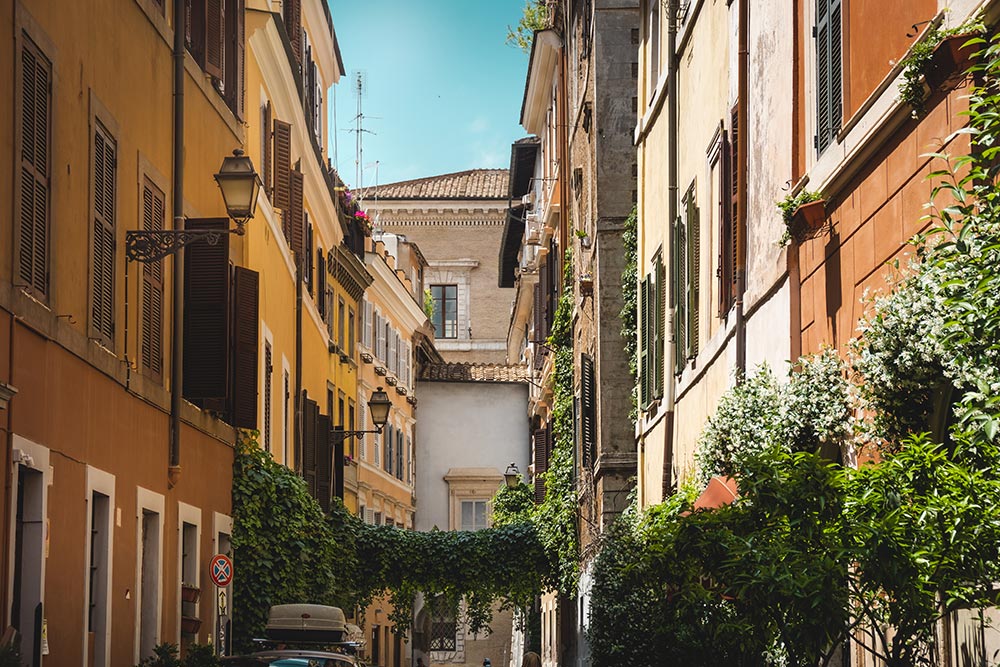 Despite being a tourist hotspot, Trastevere has managed to retain a strong local and Roman identity. By taking any side street you’ll quickly escape the crowds drawn to this area. To experience a calmer Trastevere, arrive well before 11:30 am when the tourists start to make an appearance. Be sure to come back in the evening to see why Trastevere has a name for its bustling nightlife.
Despite being a tourist hotspot, Trastevere has managed to retain a strong local and Roman identity. By taking any side street you’ll quickly escape the crowds drawn to this area. To experience a calmer Trastevere, arrive well before 11:30 am when the tourists start to make an appearance. Be sure to come back in the evening to see why Trastevere has a name for its bustling nightlife.
How to get to Trastevere
The best and easiest way to reach Trastevere is by taking the tram from either Piazza Venezia or Largo di Torre Argentina. Even though it’s a short enough distance to walk, you’re better off saving your energy for the walking tour. Be sure you wear comfy shoes as the cobblestones are very unforgiving.
Self-Guided Trastevere Walking Tour
Put your comfy shoes on, grab that camera because this walking tour is like a postcard come to life. Below is a map of Trastevere which marks all the spots visited in this walking itinerary of Trastevere.
1. Via della Lungaretta
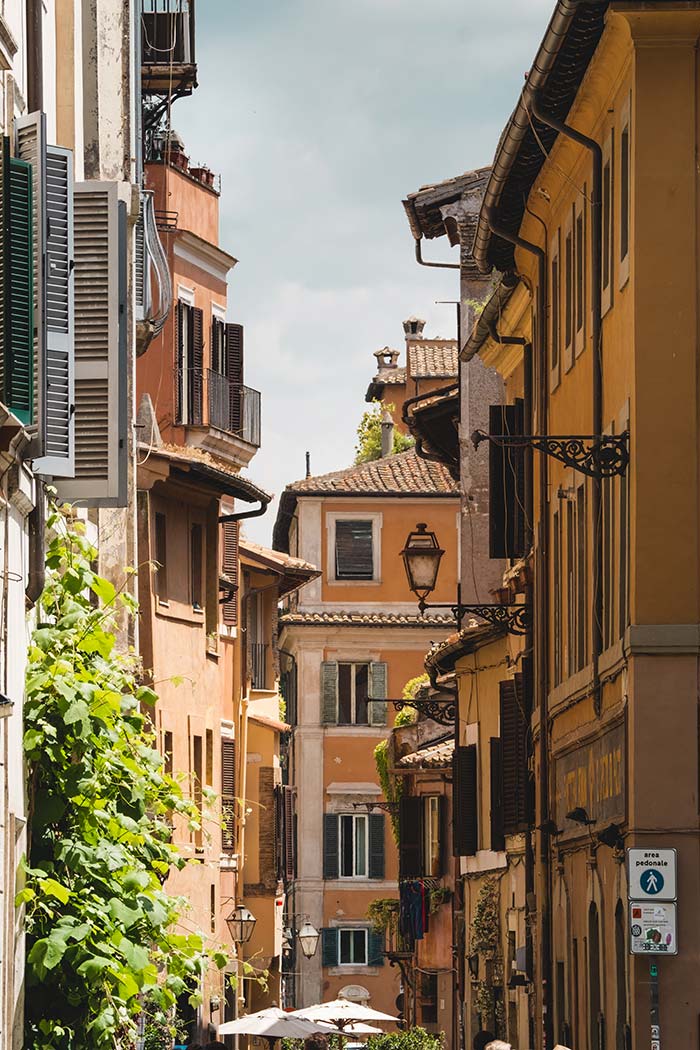 Getting off at the first tram stop after bridge, turn left and head down Via della Lungaretta. You are now walking through 2000 years of history because this road follows the exact route of an ancient Roman road! Impressive, right?
Getting off at the first tram stop after bridge, turn left and head down Via della Lungaretta. You are now walking through 2000 years of history because this road follows the exact route of an ancient Roman road! Impressive, right?
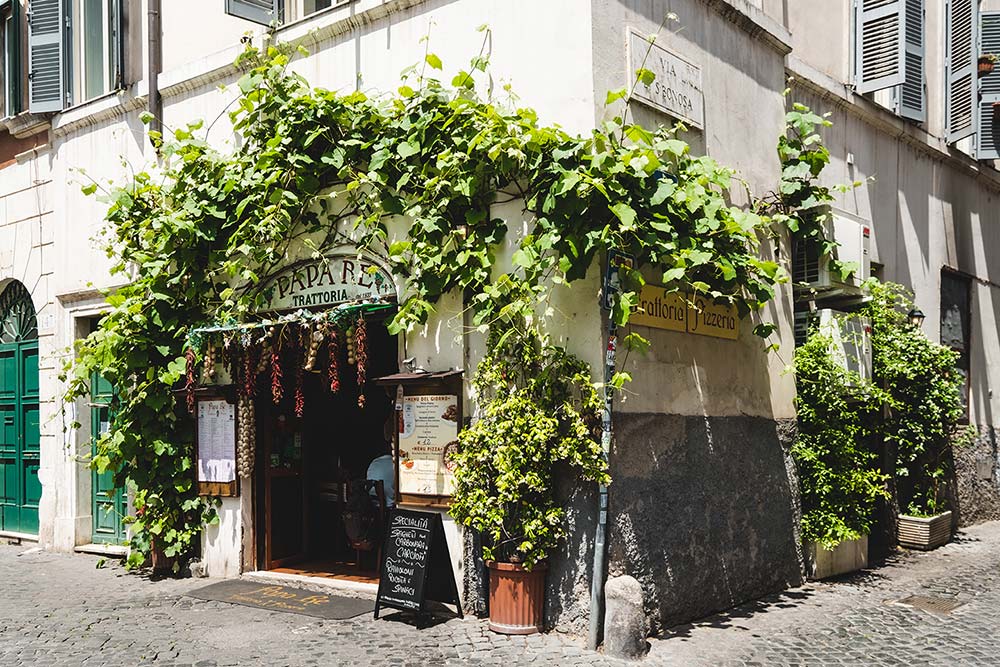
2. Vicolo della Luce
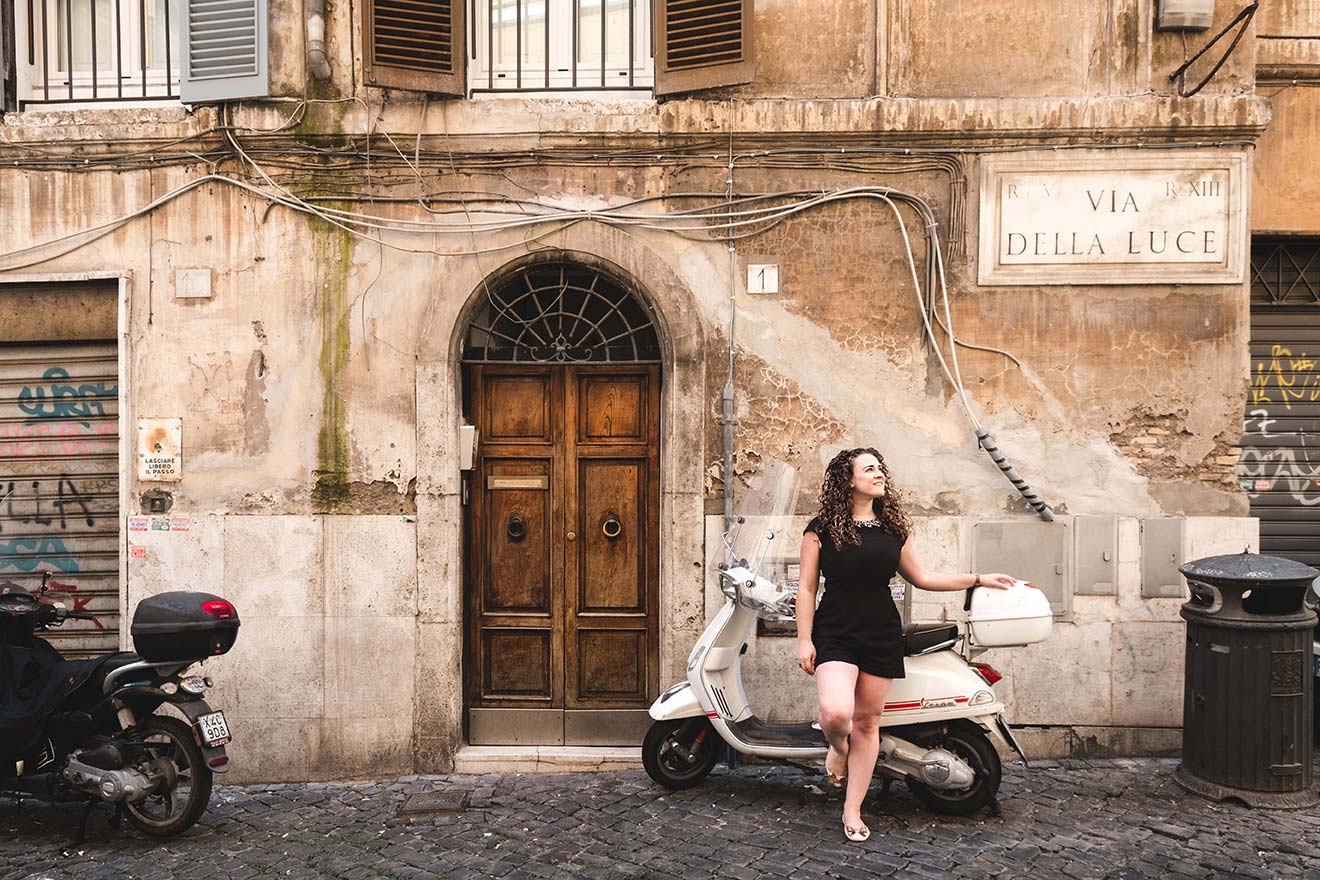
Half way down Via della Lungaretta is Vicolo della Luce, or ‘Alley of Light’. This street was made famous in a 19th century painting by E. Roesler Franz, an Italian painter and photographer. Spend a moment here and admire the medieval style home which even after restoration and reconstruction still manages to catapult you back in time.
3. Via in Piscinula
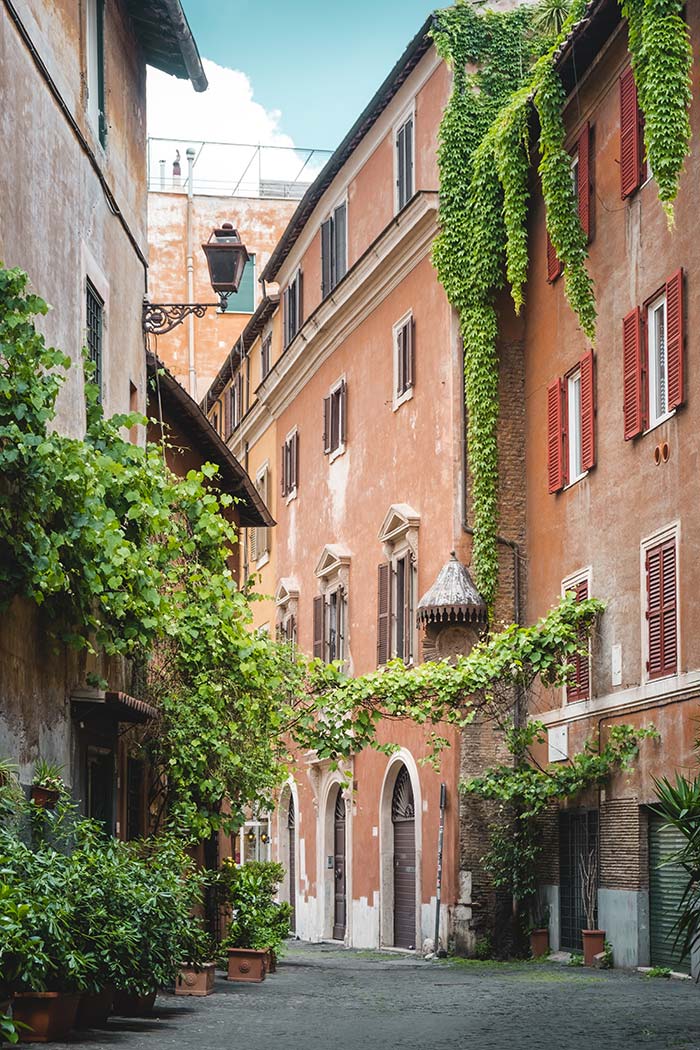
Continuing along Via della Lungaretta, pass through Piazza in Piscinula, it’s here that you’ll fall in love with Trastevere. From Spring, vines drip from the buildings as they inject an explosion of green along the rustic orange facades. Walk the entire length of Via in Piscinula before heading to Via Titta Scarpetta.
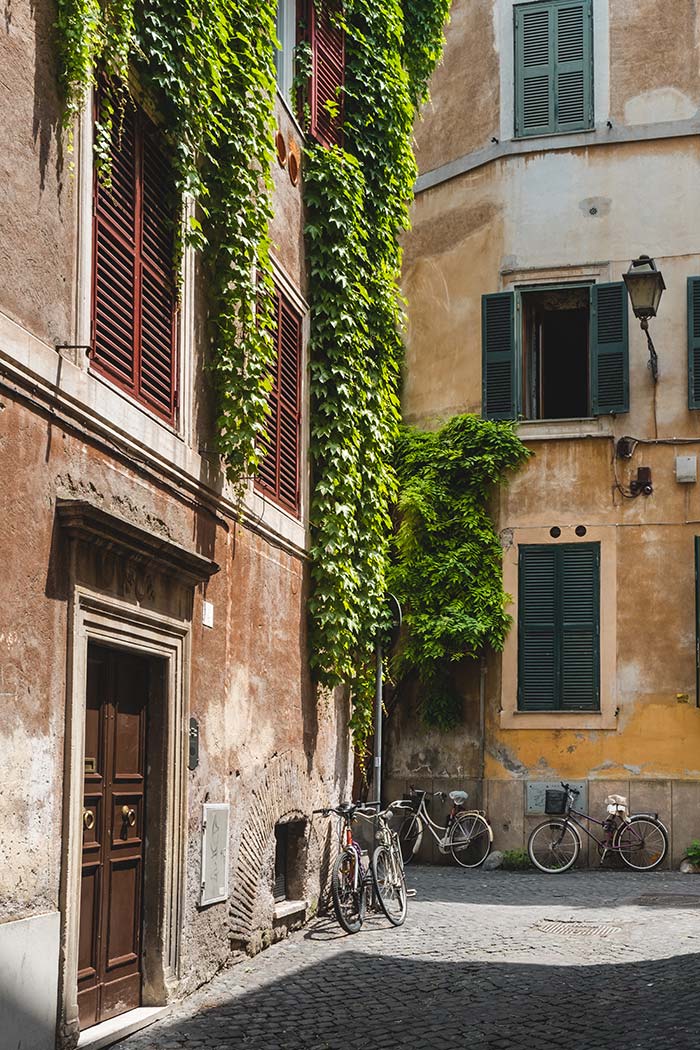
4. Via Titta Scarpetta
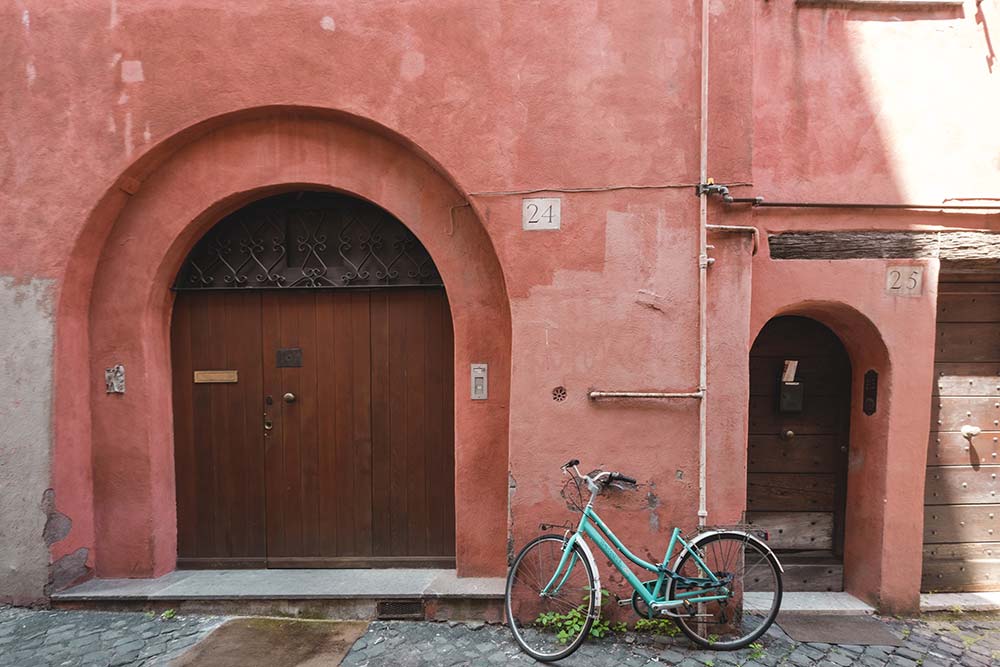
Equally quaint, this narrow street is a kind of open museum with many archeological artifacts, columns, capitals, friezes, portraits and religious medallions embedded in the walls of the buildings. This display of ancient finds harps back to an ancient tradition of exhibiting such uncovered artefacts.
The name of the street is unclear with several theories going around. Some say it could have derived from a soldier named Titta Scarpetta who lived in this street and sacrificed his life in 1559 during the siege of Malta against the Turks, thus preventing the conquest of the island.
Others believe the name derived from the sign of an inn that later gave the street its name. Another explanation is that it came from an ancient marble fragment of a Roman statue that depicted a shod foot which was stuck in the wall at the corner of the alley that later disappeared.
5. Vicolo dell’Atleta
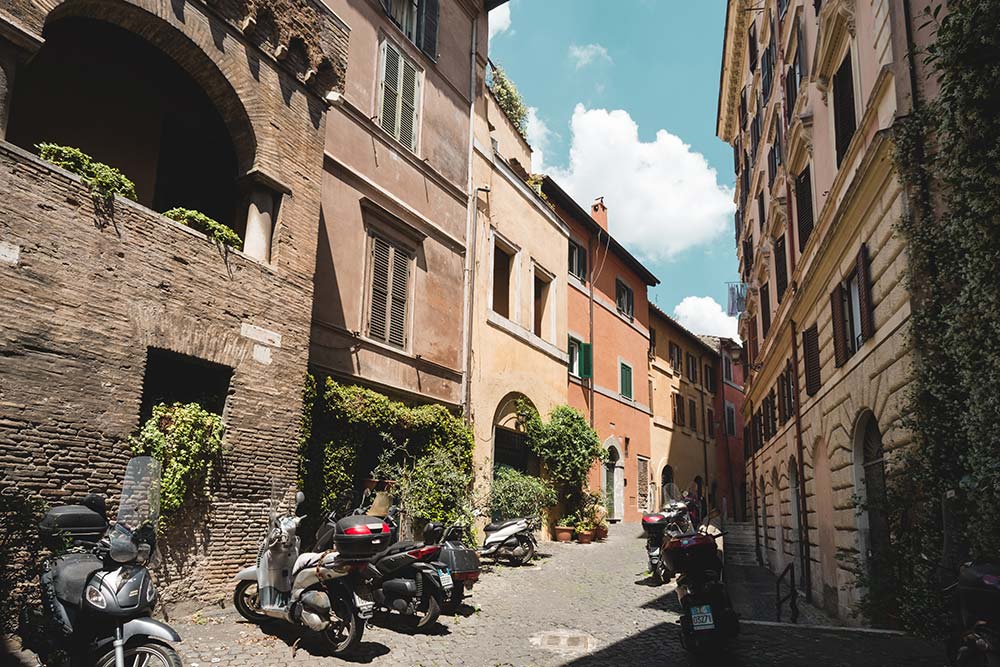
The name Vicolo dell’Atleta, meaning ‘Athlete Alley’ comes from a statue of an athlete found here in the 19th century. Today, it can be found in the Vatican Museums. Before it was Vicolo dell’Atleta it was called Vicolo delle Palme or ‘Palm Alley’. This area was the site of first Jewish Roman settlement, so it makes sense that the palm and symbol of the Judea, ( in medieval times pilgrims carried with them to Jerusalem) left its mark in the streets original name.
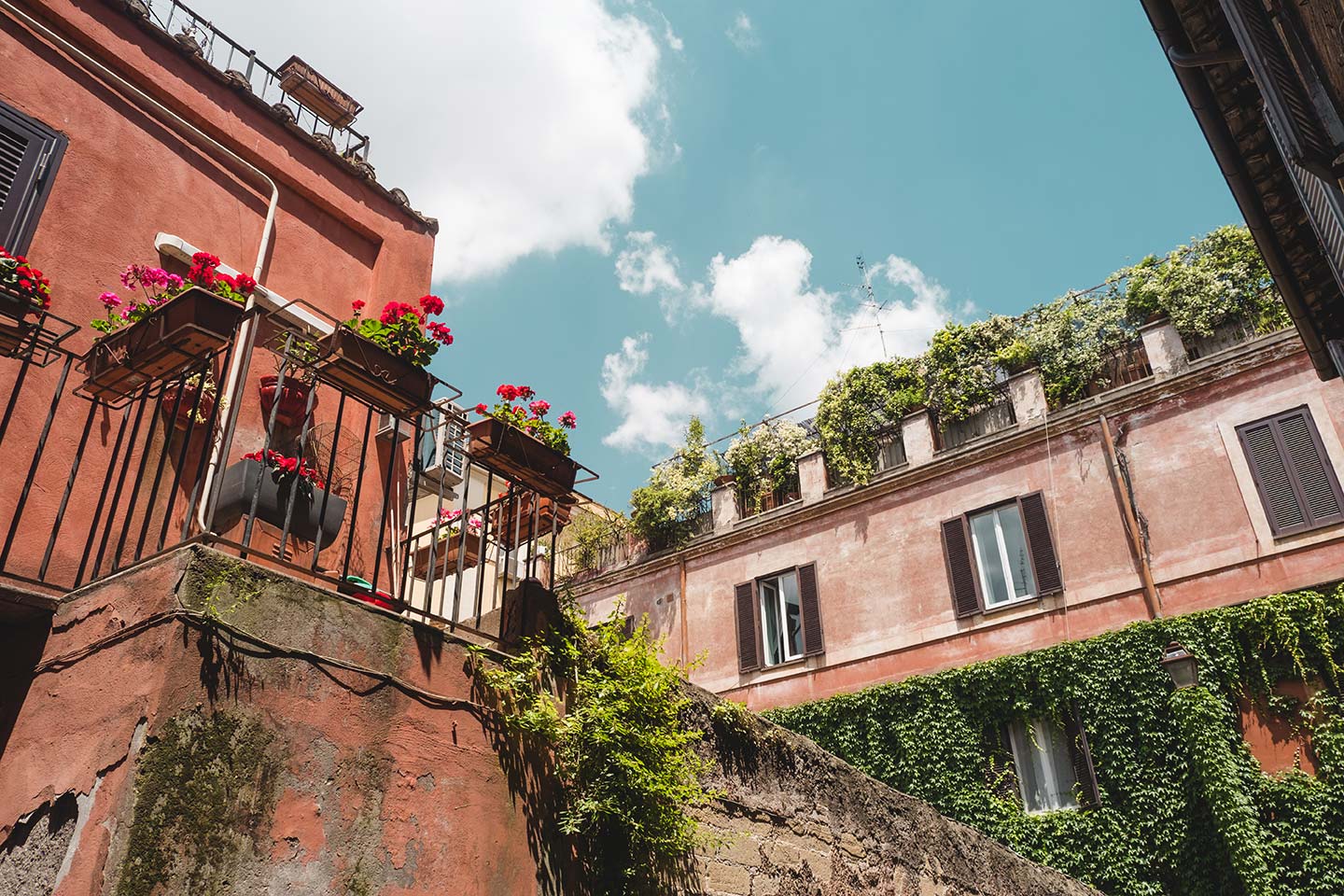
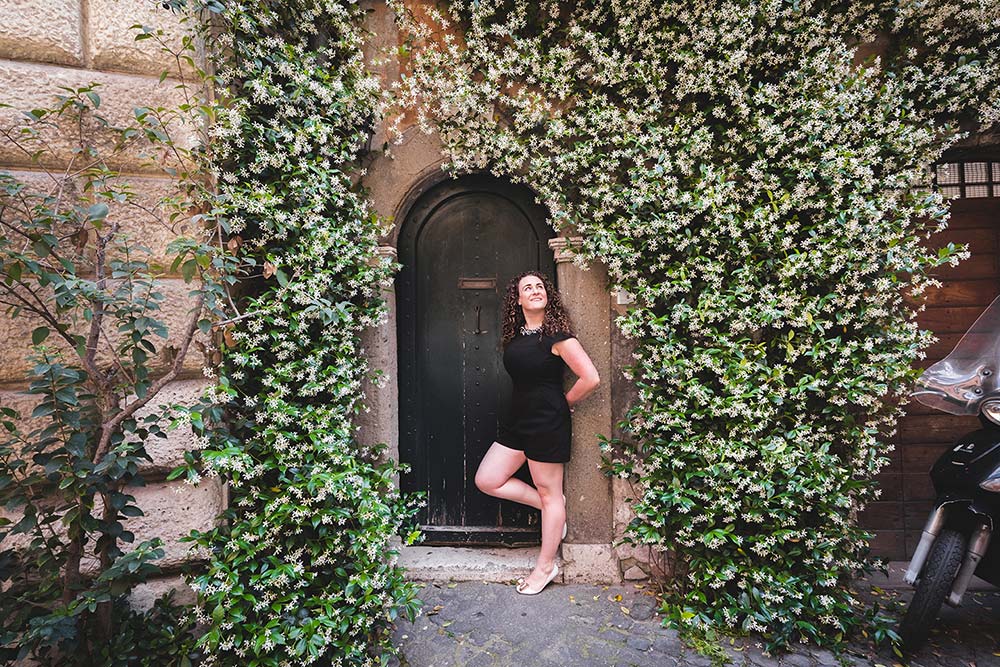
Around year 1,000 the Jews built Rome’s first synagogue here. In the 18th century, the synagogue collapsed which saw the Jews move to the ghetto. Today, in the synagogue’s presumed location stands a medieval house with beautiful arches and columns.
6. Basilica di Santa Cecilia
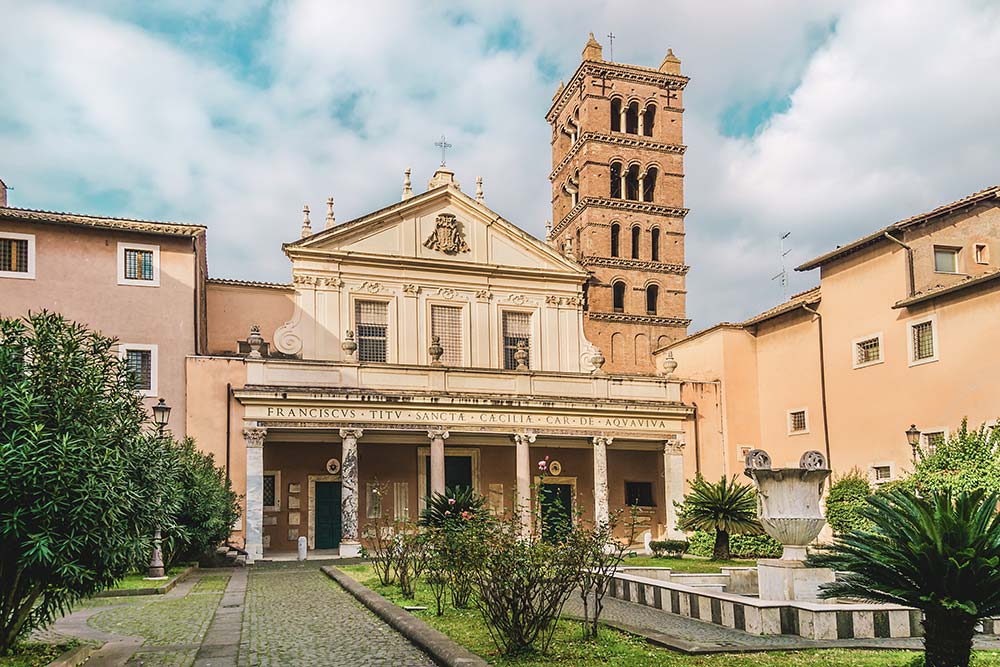 With over 1000 churches in Rome Basilica di Santa Cecilia is the first we visit in this walking tour. This early Roman Christian church was founded in the fourth century and was supposedly built on the same location where the Roman martyr Cecilia lived. Cecilia is the patroness of musicians and is represented in both a statue under the altar and in the frescoes inside the church.
With over 1000 churches in Rome Basilica di Santa Cecilia is the first we visit in this walking tour. This early Roman Christian church was founded in the fourth century and was supposedly built on the same location where the Roman martyr Cecilia lived. Cecilia is the patroness of musicians and is represented in both a statue under the altar and in the frescoes inside the church.
7. Chiesa di San Francesco a Ripa
For those interested in Francis of Assisi, it’s worth paying a visit to Chiesa di San Francesco a Ripa. This church was named after the Saint who lived here while he was visiting the Pope. The name ‘a Ripa’ comes from Porto Di Ripa Grande sul Tevere which is located behind it.
Not to be missed, is the emotive marble masterpiece ‘Blessed Ludovica Albertoni’ (‘Estasi di Beata Ludovica Albertoni’) sculpted by Gian Lorenzo Bernini between 1671-1674.
Heading west, it’s time to explore the other side of Trastevere.
8. Via di San Gallicano
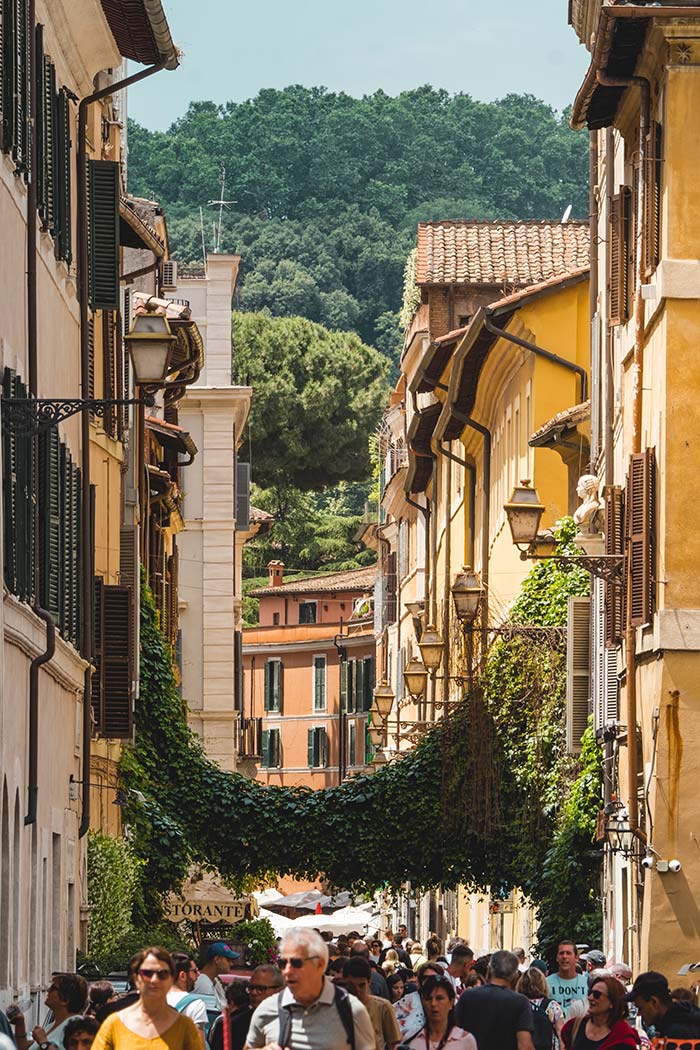 It may seem counter-intuitive to head to Via di San Gallicano first, but this is the best way entry point to this part of Trastevere. Via Di San Gallicano takes its name from the impressive 18th-century building of Hospital San Gallicano. At the time it was built, it was considered one of the best and most advanced hospitals in Europe.
It may seem counter-intuitive to head to Via di San Gallicano first, but this is the best way entry point to this part of Trastevere. Via Di San Gallicano takes its name from the impressive 18th-century building of Hospital San Gallicano. At the time it was built, it was considered one of the best and most advanced hospitals in Europe.
9. Chiesa Sant’Agata in Trastevere
The 18th-century Church of Sant’Agata in Trastevere is home to the statue of the Virgin Carmen (Vergine del Carmelo). The faithful carry the statue in the procession ‘Festa de Noantri’ which dates back to the start of the 16th century.
This religious celebration of the Madonna of Mount Carmel takes place between 16-31 July and is one of the last popular religious festivals remaining in Rome.
10. Piazza di Santa Maria in Trastevere
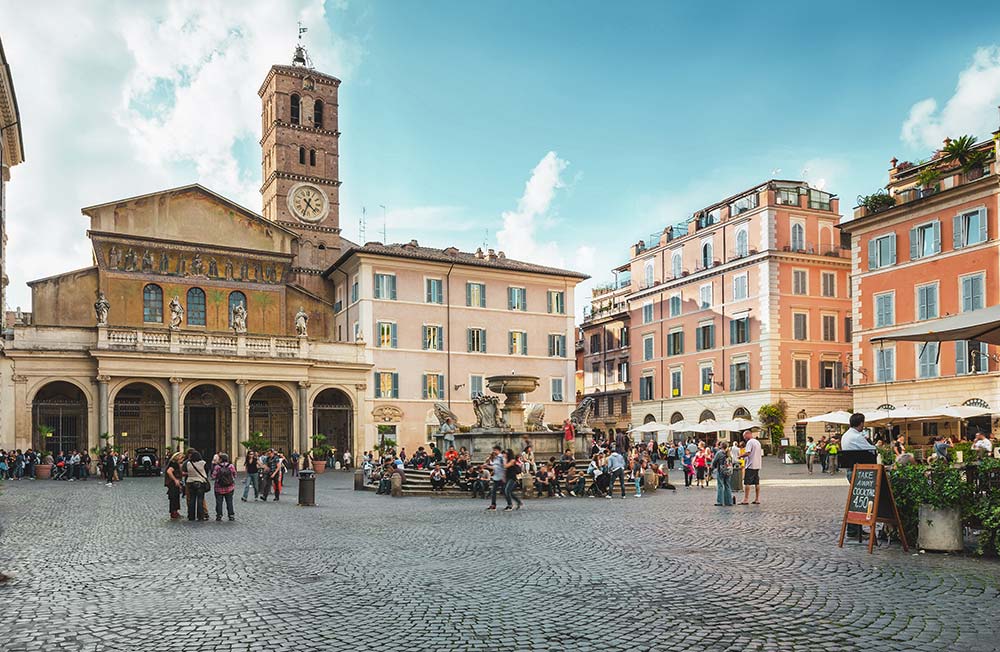 Continuing along the Via della Lungaretta will take you to Trastevere’s focal square, Piazza di Santa Maria in Trastevere. The Roman fifteenth-century fountain that sits in the centre of the square is said to be the work of Bramante.
Continuing along the Via della Lungaretta will take you to Trastevere’s focal square, Piazza di Santa Maria in Trastevere. The Roman fifteenth-century fountain that sits in the centre of the square is said to be the work of Bramante.
Guidebook-toting tourists, students of the nearby University and locals give this piazza a dual personality. By day the glittering gold mosaics of Basilica of Santa Maria dazzle onlookers before giving way to the atmospheric warm nights with bustling bars and alfresco dining tables.
As the heartbeat of Trastevere, various markets, musical and cultural events take place in the piazza.
11. Basilica di Santa Maria in Trastevere
After being under restoration for an extended period, Basilica di Santa Maria in Trastevere is finally back to her shining glory.
Dating back to the 3rd century, Basilica di Santa Maria in Trastevere is one of the oldest churches of Rome and without a doubt the most important place of worship in Trastevere.
Its most famous feature is its large 13th-century mosaics by Pietro Cavallini. Above the entrance is a huge golden mosaic which glimmers in the golden sun throughout the day.
Making a slight detour, make your way to Via della Cisterna to see Fontana della Botte.
12. Fontana delle Botte
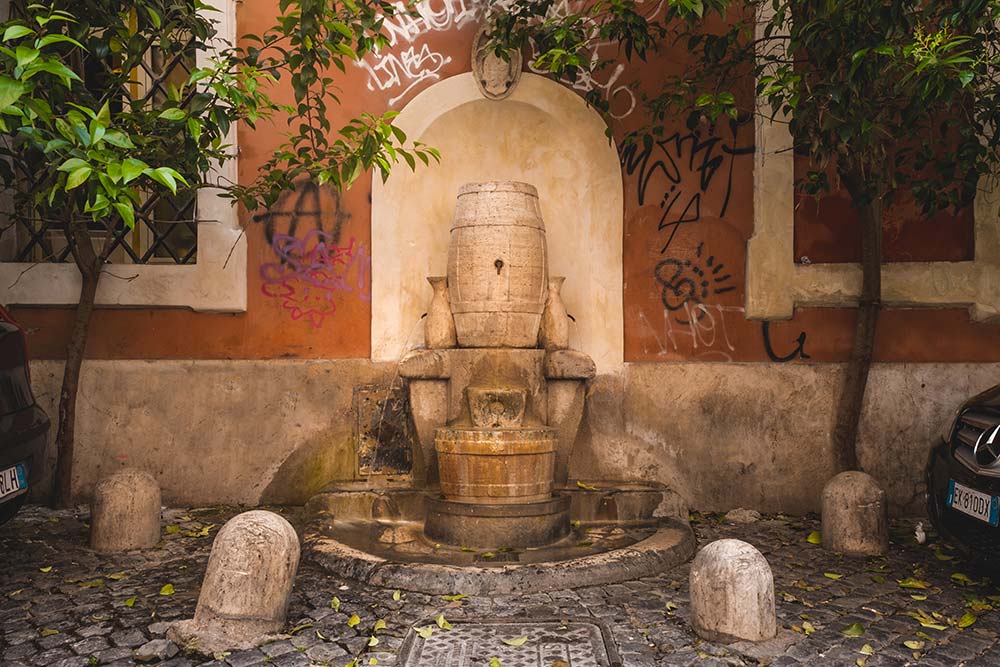 While it may not be as old as other points of interest in Trastevere, Fontana delle Botte pays particular homage to the district’s long rich history of wine commerce.
While it may not be as old as other points of interest in Trastevere, Fontana delle Botte pays particular homage to the district’s long rich history of wine commerce.
Built in 1927, the fountain shows the elements necessary for the production and consumption of wine including the barrel, the wine vat, and the two containers at the side of the barrel commonly called ‘quartini’ by Romans.
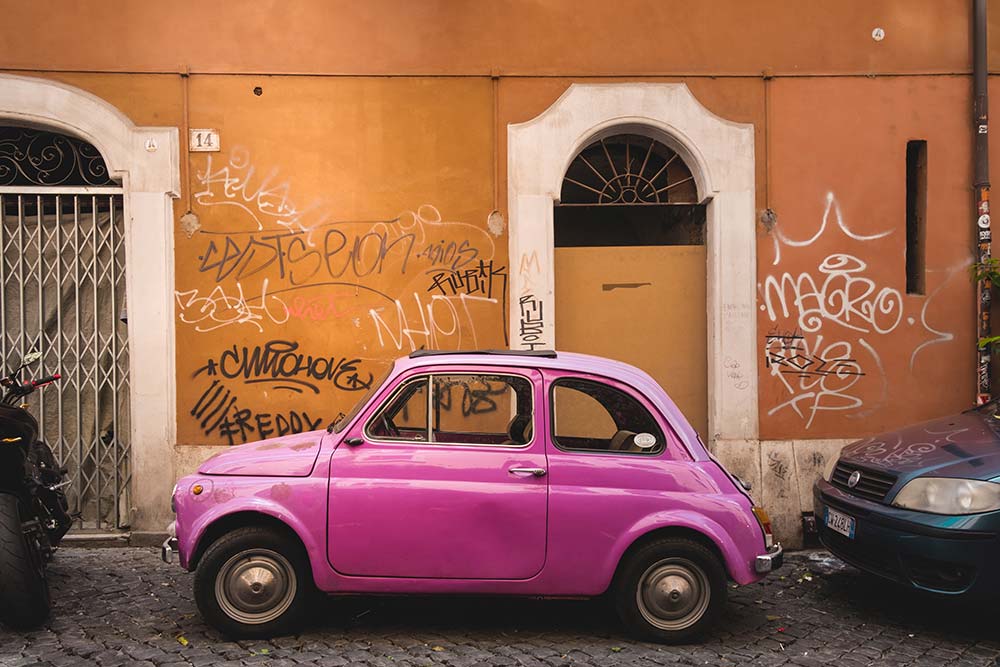
13. Vicolo del Piede
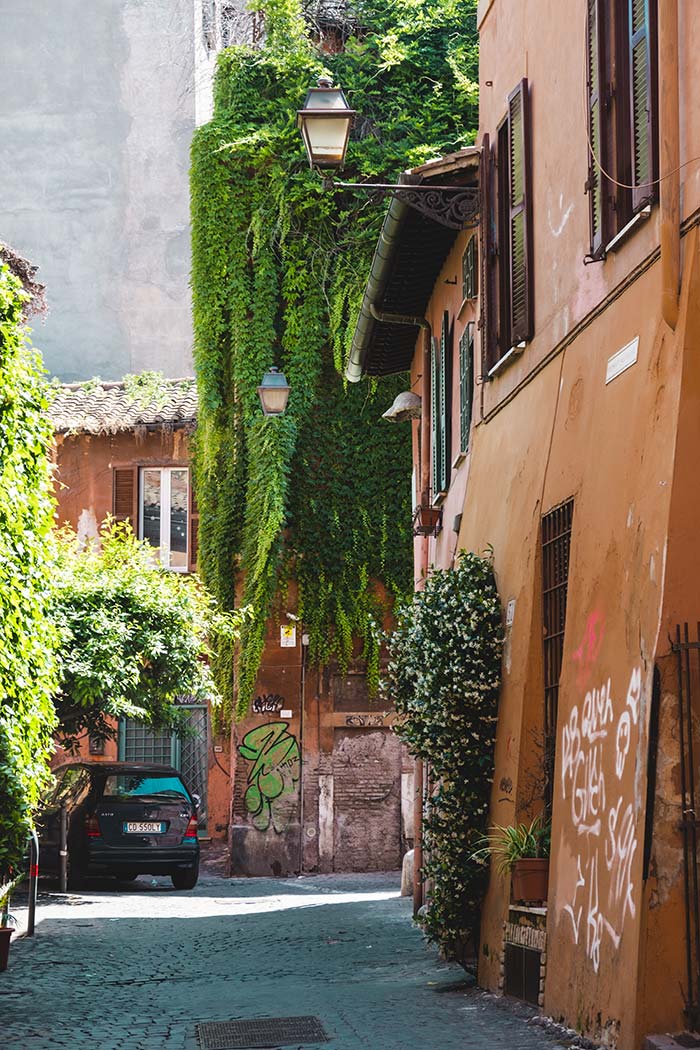
Retrace your steps towards Piazza di Santa Maria in Trastevere and step off the beaten track to the quiet Vicolo del Piede, aka Foot Alley.
This tiny narrow street is a photographers dream with plants scaling the walls of the houses.
14. Via del Moro and Caffè Moro
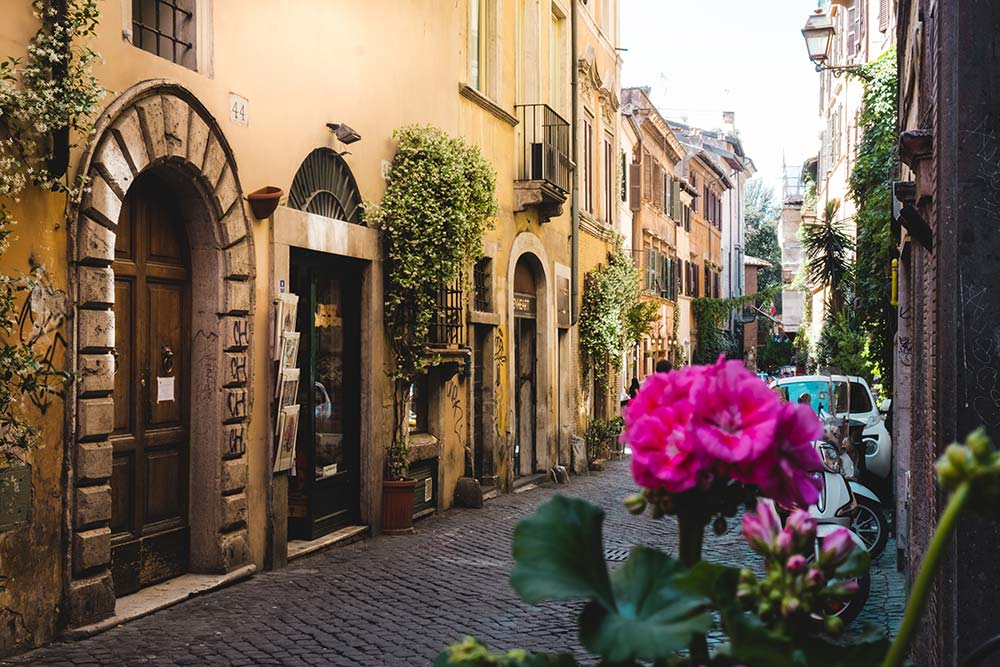 At the end of the street, take a right to Via del Moro. This lovely street is dotted with buildings in various architectural styles from the medieval period to the 17th century through to the Renaissance.
At the end of the street, take a right to Via del Moro. This lovely street is dotted with buildings in various architectural styles from the medieval period to the 17th century through to the Renaissance.
Dating back to the end of the nineteenth century, you’ll find the historical Caffè Moro, one of oldest cafès still active in Italy. The cafè still has its original sign in painted wrought iron which goes back to the Abyssinian War at the end of the 19th century.
15. Vicolo de’ Cinque
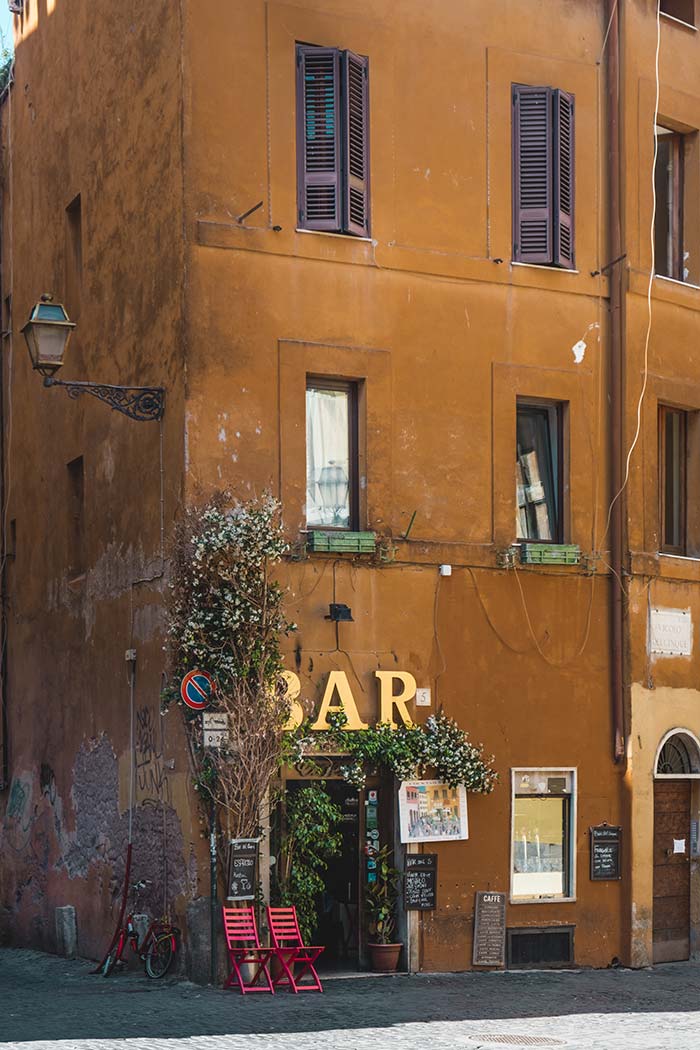 Connecting Piazza Trilussa with Via della Scala, Vicolo del Cinque gets its name from the palace of the ancient family Cinque, which dominates it. In the evenings, this street comes to life with busy restaurants overflowing into the street.
Connecting Piazza Trilussa with Via della Scala, Vicolo del Cinque gets its name from the palace of the ancient family Cinque, which dominates it. In the evenings, this street comes to life with busy restaurants overflowing into the street.
Want to learn more about Roman food? Join this popular Roman Food tour in Trastevere.
16. Piazza Trilussa and Fontana di Ponte Sisto
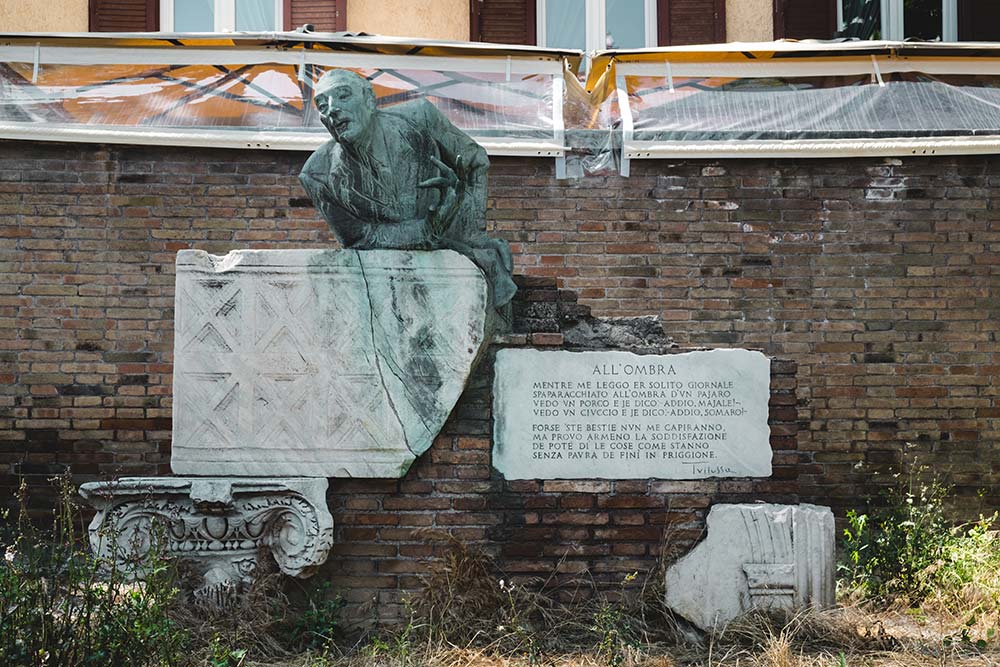 Piazza Trilussa is a popular meeting point before taking one of the many arteries leading into Trastevere. I can’t count the number of times I would wait on these steps for my notoriously late Italian friends.
Piazza Trilussa is a popular meeting point before taking one of the many arteries leading into Trastevere. I can’t count the number of times I would wait on these steps for my notoriously late Italian friends.
Piazza Trilussa was named after the Italian poet Carlo Alberto Salustri, better known by his pen name of Trilussa. He was famous for his poems written in the dialect of Rome, Romanesco. To the side of the piazza is a monument dedicated to Trilussa.
17. Vicolo Moroni
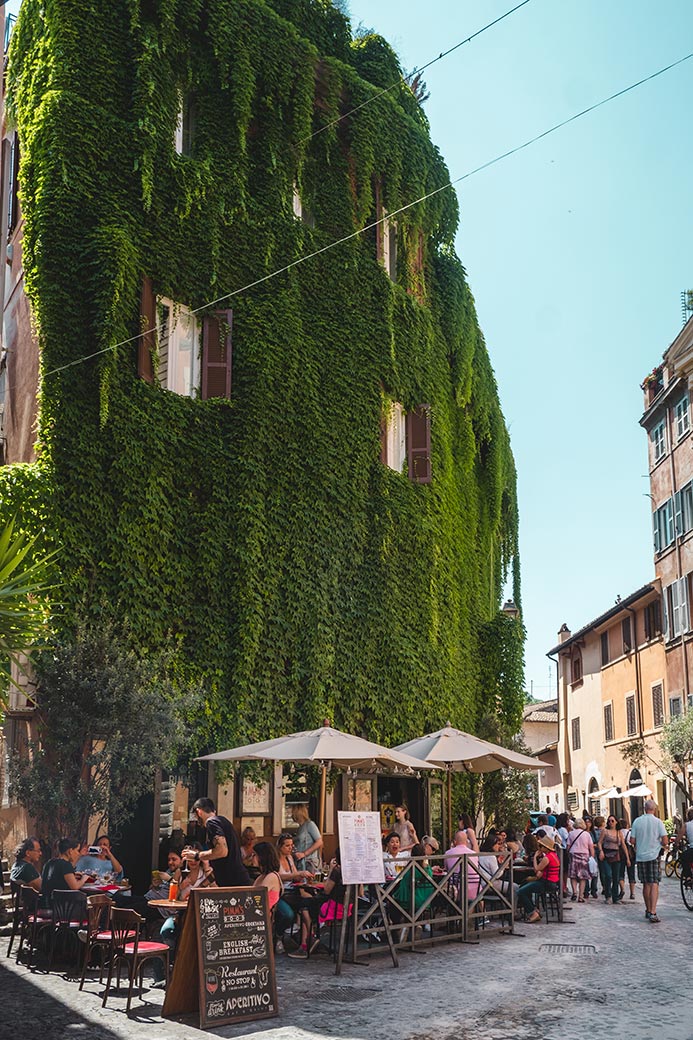 Just off Piazza Trilussa is Vicolo Moroni. This tiny street is made special for being the only place in Trastevere where you can see the remains of the Aurelian Wall ( built between 271 AD and 275 AD) which once surrounded the city of Rome.
Just off Piazza Trilussa is Vicolo Moroni. This tiny street is made special for being the only place in Trastevere where you can see the remains of the Aurelian Wall ( built between 271 AD and 275 AD) which once surrounded the city of Rome.
18. Via della Scala
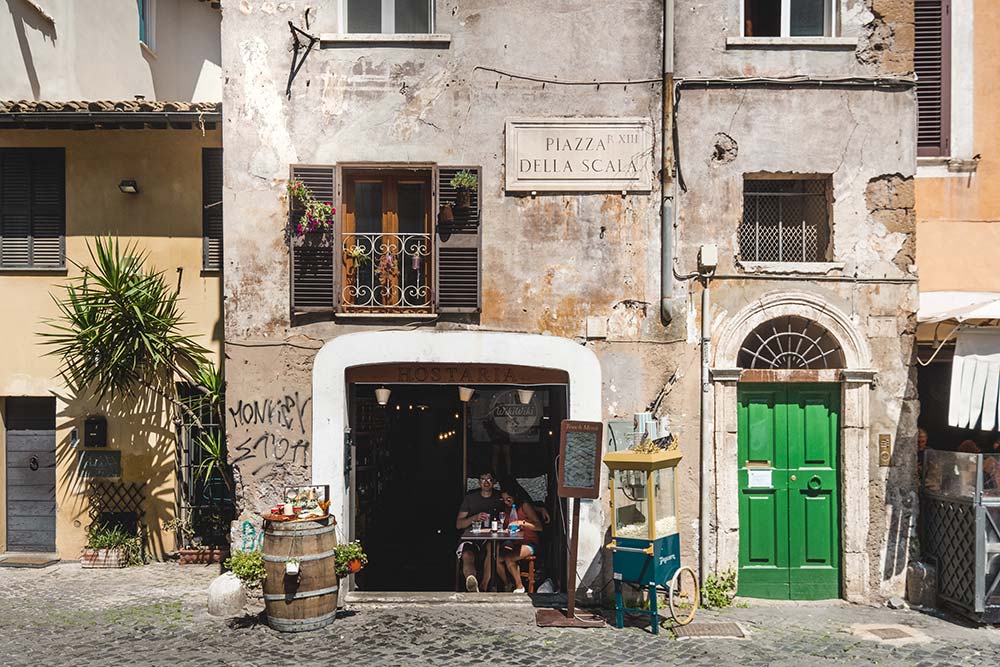 Set amongst tangerine-coloured houses and located next to the convent of Santa Maria della Scala is Farmacia dei Frati Carmelitani (Carmelite monks pharmacy). It was here that ancient monks used to prepare medicines. While the pharmacy isn’t active, you can still visit the premises and see where the monks worked.
Set amongst tangerine-coloured houses and located next to the convent of Santa Maria della Scala is Farmacia dei Frati Carmelitani (Carmelite monks pharmacy). It was here that ancient monks used to prepare medicines. While the pharmacy isn’t active, you can still visit the premises and see where the monks worked.
19. Fontana del Prigione
Before heading up Janiculum Hill, swing passed Fontana del prigione or ‘Prison Fountain’.
This fountain was originally one of the monuments that adorned the famous Montalto villa, the private residence of Pope Sisto V. Sadly, the villa disappeared in 1887 during the construction of Termini Station.
The fountain was dismantled and held in the Ministry of the Interior warehouses before it was later reassembled and placed in Via Mameli. Its name comes from a group of statues which formed part of the original composition depicting Apollo, Venus and a prisoner.
20. Chiesa di San Pietro in Montorio
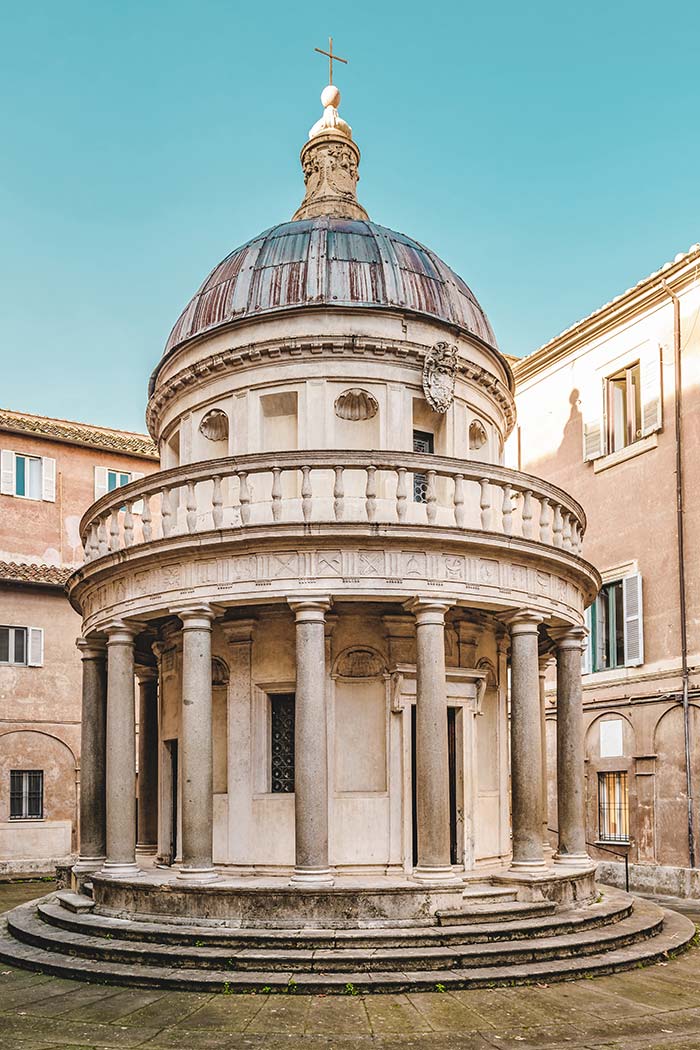 Serving as a shrine and marking the supposed site of St. Peter’s crucifixion, the Church of San Pietro in Montorio replaced an earlier 9th-century church dedicated to Saint Peter. Its nickname ‘Montorio’ comes from the Latin ‘monsaureus’ referring to the yellowish soil of the Janiculum hill where it’s located.
Serving as a shrine and marking the supposed site of St. Peter’s crucifixion, the Church of San Pietro in Montorio replaced an earlier 9th-century church dedicated to Saint Peter. Its nickname ‘Montorio’ comes from the Latin ‘monsaureus’ referring to the yellowish soil of the Janiculum hill where it’s located.
Unassuming from the outside, this church boasts incredible artwork from artists including Gian Lorenzo Bernini, Daniele da Volterra and Sebastian del Piombo.
21. Fontana dell’Acqua Paola
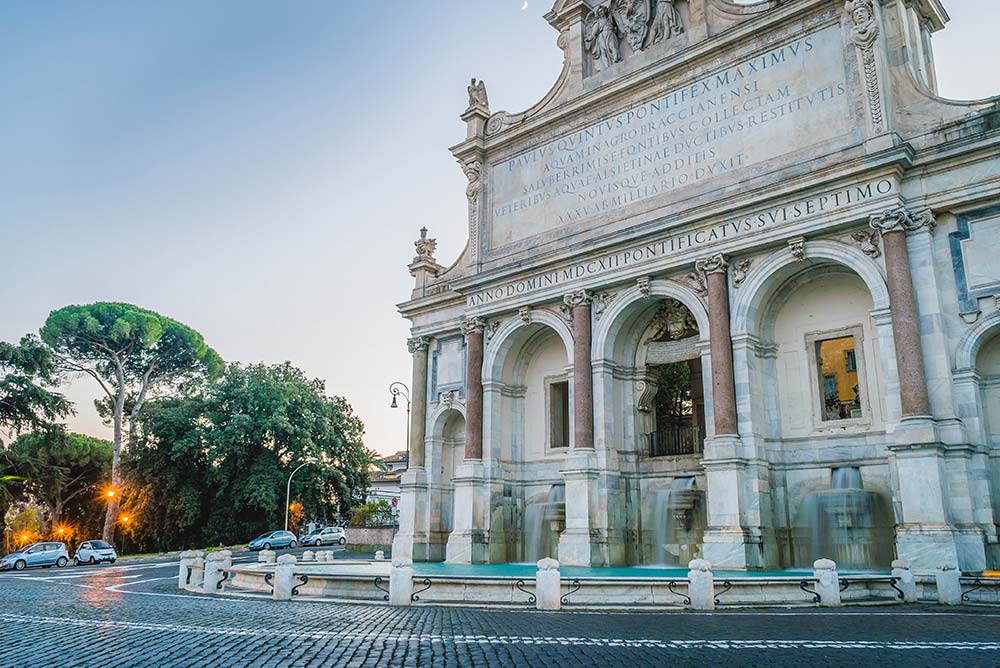 Locally known as the ‘fontanone’ or big fountain because of its impressive size, Fontana dell’Acqua Paola was the first major fountain on the right bank of the River Tiber.
Locally known as the ‘fontanone’ or big fountain because of its impressive size, Fontana dell’Acqua Paola was the first major fountain on the right bank of the River Tiber.
Located on the slopes of Janiculum Hill with gorgeous views over Rome’s historical centre, the fountain was built in 1612 to mark the end of the Acqua Paola aqueduct. It was restored by Pope Paul V from whom it took its name.
22. Gianicolo / Janiculum Hill
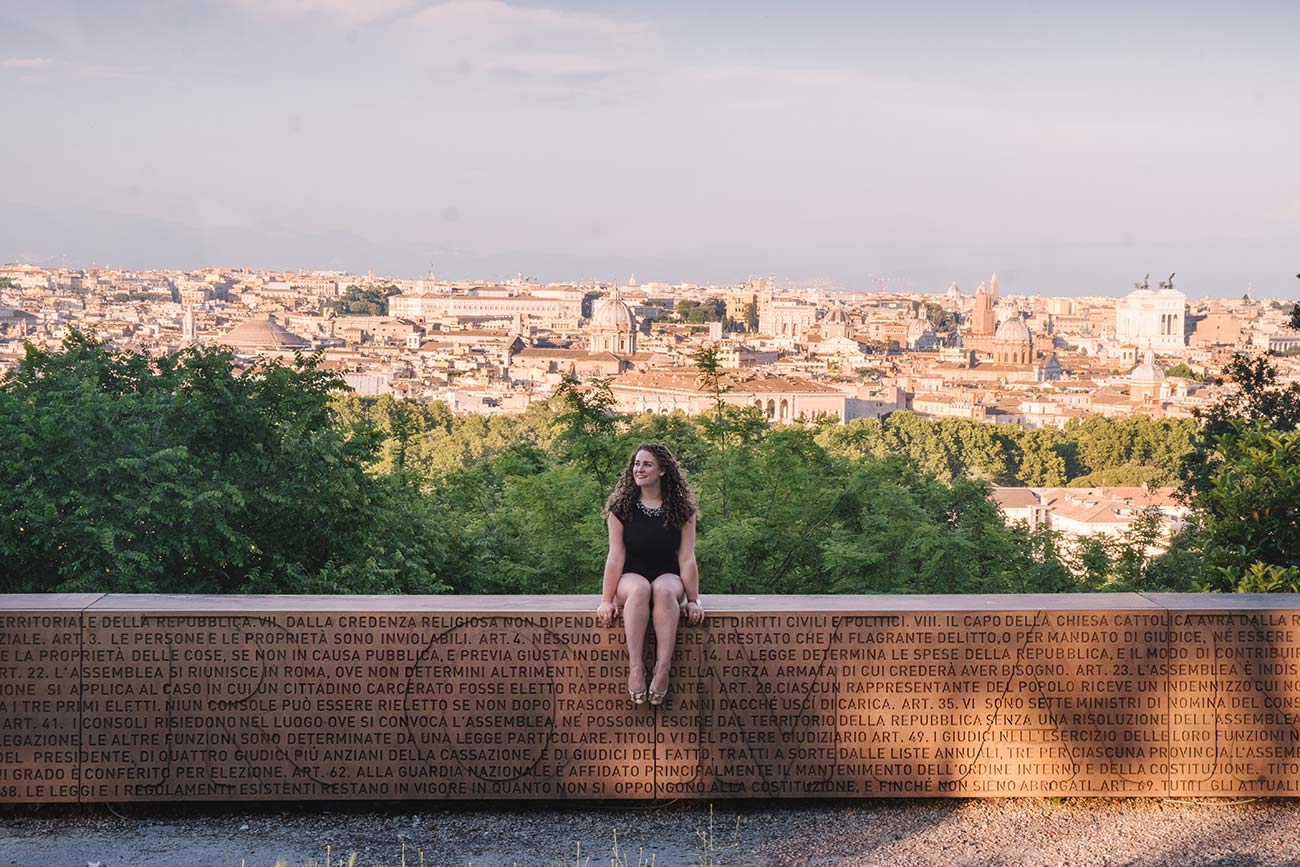 When I first moved to Italy, I was in the habit asking my taxi drivers their best locals tips. When I asked one lady what her favourite place in Rome was she quickly responded “Gianicolo!”.
When I first moved to Italy, I was in the habit asking my taxi drivers their best locals tips. When I asked one lady what her favourite place in Rome was she quickly responded “Gianicolo!”.
This makes it the perfect spot to end our Trastevere walking tour. From here you’ll get the best view of Rome that will take your breath away.
Even though Rome is known for its seven hills, Gianicolo (or Janiculum) is located on the eighth hill. It’s not included with the other hills because it sits outside of the ancient city walls.
Each day at noon a single cannon shot is fired from Gianicolo marking the exact time. This tradition that dates back to the 19th century. With that said, the best time to see Roman’s favourite view, is from late afternoon to sunset. There is a bar located near the lookout which means you can enjoy an Aperol Spritz (Italy and my favourite apertif) and light snacks, whilst enjoying pink skies form over Rome.
Also up here are the busts of heroes from the Italian Risorgimento, the 19th-century movement (and wars) that unified modern Italy. At its centre is a huge statue of the great hero Giuseppe Garibaldi on horseback.
And this concludes this walking tour around Rome’s most beautiful streets.
While this isn’t an exhaustive tour of Trastevere, it covers the major points of interest and will help you discover the smaller and quieter side of this popular part of Rome. Be sure to stray from the itinerary when something catches your eye, you never know what you’ll find.
Buona passeggiata! Enjoy your walk! Don’t miss my Rome video guide below.
Looking for a place to stay in Rome? Don’t miss my guide to the best areas to stay in Rome and top accommodation recommendations.
Don’t be treated like a tourist. Learn Italian with my 80/20 method
Travelling to Italy? Don’t be treated like a tourist! Live your best travel experiences and learn Italian for less than the cost of eating at a tourist trap restaurant or a taxi driver who has “taken you for a ride”. I’ve made it easy for you to master the Italian language so you can create lifelong memories as you mingle with locals, get local tips, avoid tourist traps, and make new friends. Who knows, you may even be invited over for afternoon tea by a lovely Sicilian family like I was! Read all about how speaking Italian changed my life and check out my online Italian video course here.
Here’s what my students are saying:

I really enjoyed the Intrepid Italian course, it certainly exceeded my expectations. The learning methodology is great, and easy to follow and found that I progressed much faster in the last 4 weeks than I ever did on my own or using other language apps. Grazie mille Michele, I can’t wait until I can put my new skills into action! – Roma Small
Click here for instant access!
Want to see more in Rome and beyond? Take a day trip
- 29 Amazing Day Trips from Rome By Train, Car & Guided Tour
- Private Helicopter Tour over Rome
- Skip the Line: Crypts and Roman Catacombs Small-Group Walking Tour
- The Roman Food tour in Trastevere
- Skip the Line: Borghese Gallery and Gardens Walking Tour
- Papal Audience Tickets and Presentation
- Rome Street Food Tour with Local Guide
- Early Access: Sistine Chapel and Vatican Museums Ticket
- Roman Gladiator School: Learn How to Become a Gladiator
- Pompei Day trip from Rome
- Small-Group Pompeii with Amalfi Coast Drive and Positano Stop from Rome
- Naples and Pompeii Day Trip from Rome
- Small-Group Rome Food Walking Tour: Trastevere, Campo de’ Fiori and Jewish Ghetto
- 4-Day Tuscany and Cinque Terre Tour from Rome
- Exclusive Catacombs After Closing and Bone Chapel Tour
- Tivoli Day Trip from Rome: Villa d’Este and Hadrian’s Villa
- Florence Day Trip from Rome
- Venice Independent Day Trip from Rome by High-Speed Train
Don’t miss these Italy travel guides
- 33 Italy Travel Tips That Will Save You Time, Money and Disappointment
- Rome Tips and Tricks: 27 Things You Should Know Before You Go to Rome
- Top 10 Things to Do in Rome That Aren’t On Your List
- Top 10 Absolute Best Views of Rome That Will Blow Your Mind
- Where to Stay in Rome | Best Hotels and Best Neighborhoods to Stay in Rome
- 20 Top Hotels Near the Pantheon in Rome for Every Budget
- Domus Aurea: Visit Rome’s Secret Hidden Palace
- Absolute Best Things to do in Verona, Italy | 26 Must-See Attractions
- 21 Unique Things to Do in Venice You Should Try at Least Once
- Top 7 Authentic Tours and Experiences in Rome [Run by Locals]
- Lakes, Mountains & Castles: 21 Best Things to do in Trento, Italy
- Italy Fun Facts: 126 Unique Things You Didn’t Know About Italy
- 36 Wonderful Things to do in Umbria, Italy (PLUS Map of Umbria)
Like it? Pin it for later
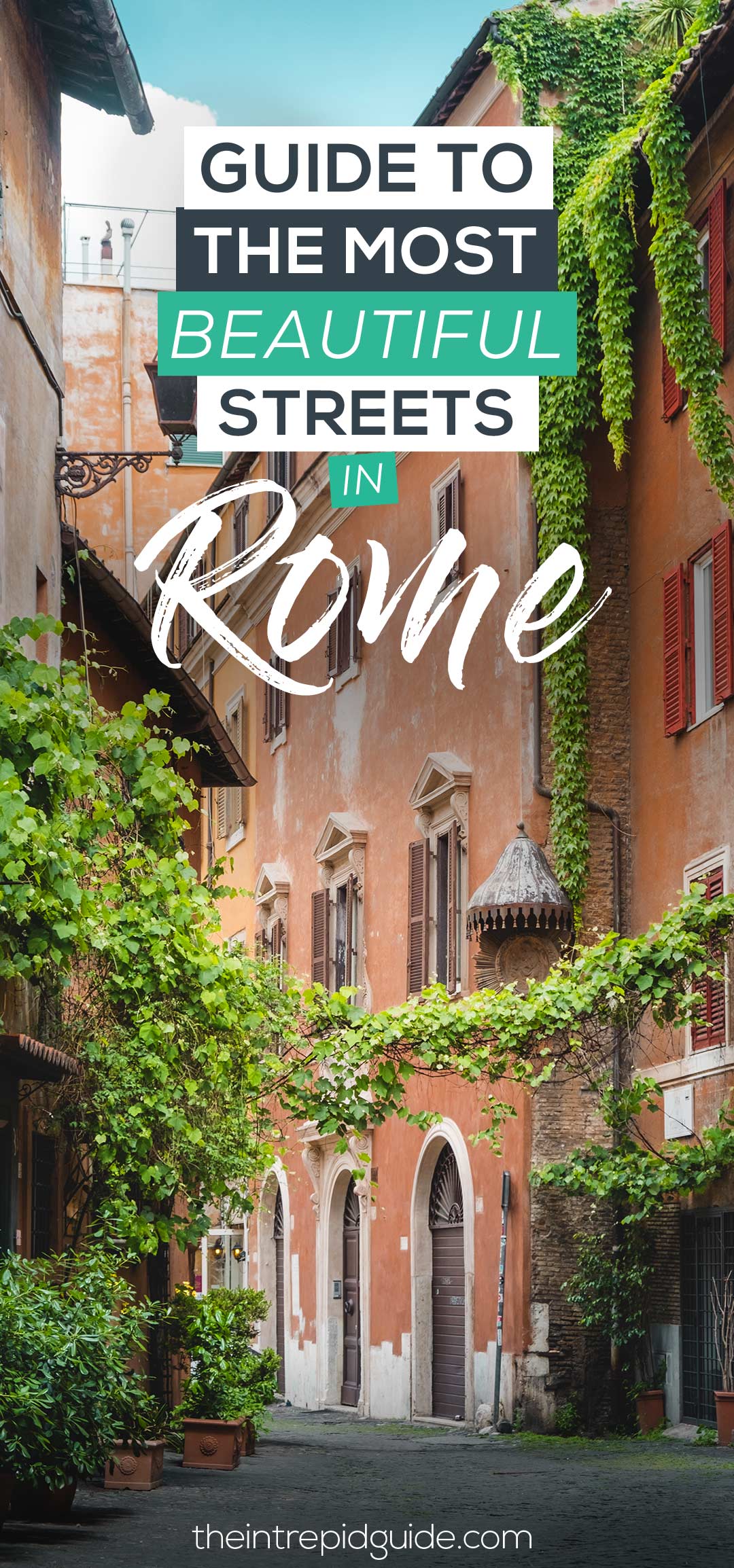
Over to you!
Have to you visited Trastevere? What else would you recommend doing to seeing? Tell me below!
Let me know using the comments section below or join me on social media to start a conversation.
Thanks for reading and I hope you enjoyed this post.
Like what you see? Subscribe using the form below to have all of my posts delivered directly to your email.

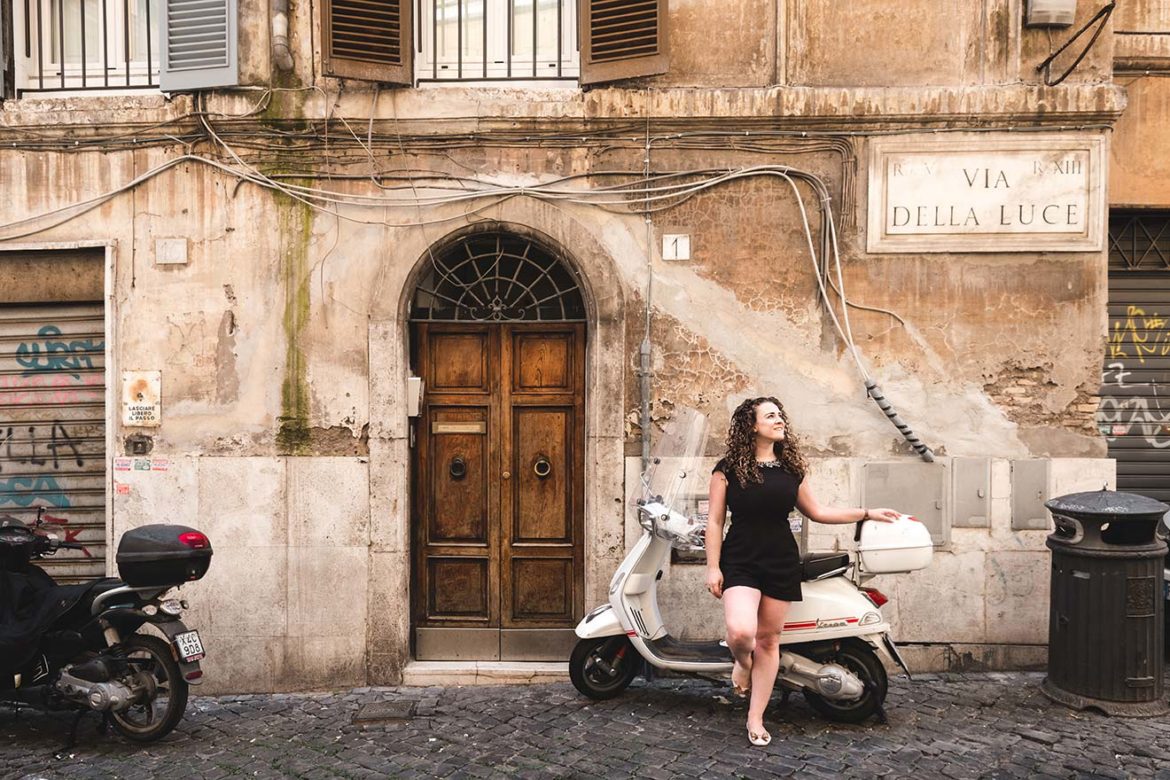
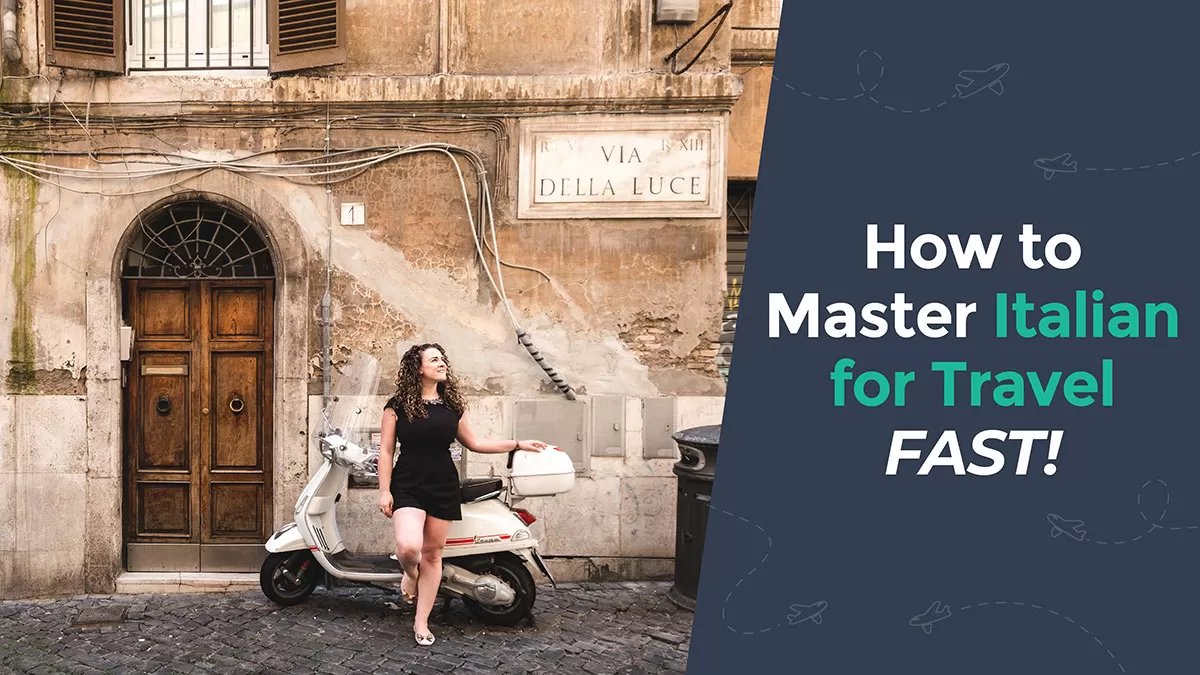
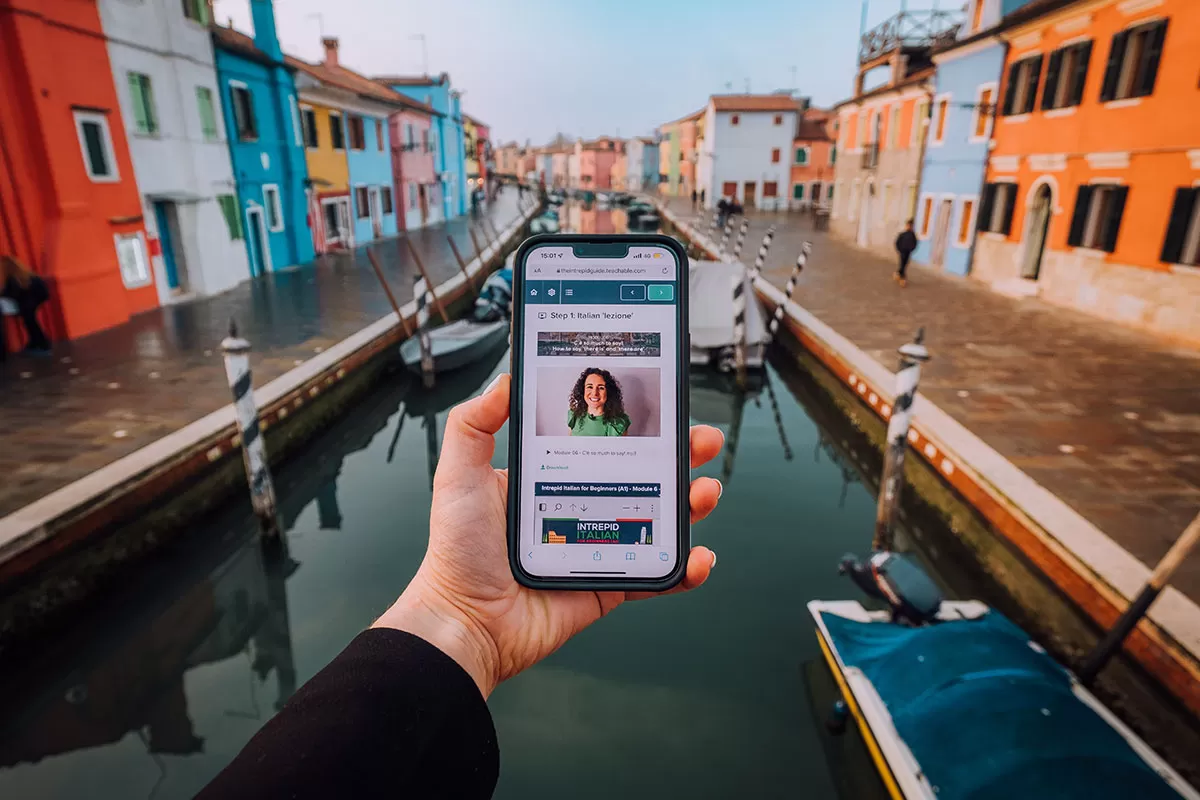
3 comments
We wanted to thank you for this post. We are two retired Canadians who stayed in Trastevere for a week. We used it today to guide ourselves around Trastevere. We did get lost a few times (no help from a few missing via signs) but figuring it out was half of the fun. We appreciated your background research for the many different areas. We would never have seen a bunch of sites you feature if not for your article. Thanks for your work on this – it was a fun morning!
I’m so happy to hear you enjoyed this guide and had a lovely trip to Rome :)
Thank you, Madam ! Very romantic !
“Rome, thou art a whole world, it is true, and yet without love this
World would not be the world, Rome would cease to be Rome…”